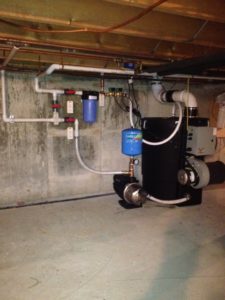Removal Of Radon From Water
RADON
Removal of Radon from Water Systems
The removal of radon from water is limited to two practical options.
One technique uses activated carbon to adsorb the radon gases from the water. The radon gas then finishes decaying in the carbon. Activated carbon should only be used if the radon concentration in the water is below 5000 pCi/L. This low level is recommend by the EPA in their “Consumer’s Guide to Radon Reduction” because of the concern over the accumulation of radioactivity in the carbon.
Aeration is used for treating water with radon levels above 5000 pCi/L. The radon is released from the water by bubbling air through the water. The radon is then vented to the outdoors. There is no build up of radioactive materials when this technique is used. Aeration units do require the repressurization of the water after it is treated and care must be taken to properly vent the radon gas. This venting is done above the roof line just like an air radon system. An auxiliary fan outside of the living space provides for safe removal of the radon gas.
HOME INSPECTION TESTING FOR RADON IN WATER
The EPA suggests the radon level in the water should be tested if there is a private well and an elevated radon gas concentration is found in the home. This is good advice for a home owner but not necessarily good advice for a home buyer. In many cases, homes being sold are unoccupied and, therefore, there will be no contribution to the air radon gas concentration in the air from the water during a radon home inspection. In this case (no water usage), the air radon gas level in the air can be low and the radon concentration in the water can be very high. We have fixed homes where the air radon level was high (sometimes as much as 60 pCi/L) and the only reason for this elevated reading was because the radon was being released into the air from the water. If these houses had been tested while there was no water being used, there would not have been enough air radon in the test result to suggest further inspection.
A home owner can purchase a radon test kit (contact Air & Water Quality Inc. to purchase your kit!) and administer the sampling by following the test kit instructions. If the test is being done for a real estate transaction, by State law it is required that testing be performed only by a registered radon testing provider. Real estate brokers, unless they are registered as a radon testing provider, can not legally take radon samples. Many home inspectors are registered radon testing providers.
HOW RADON GETS INTO THE WATER AND THEN INTO THE AIR
Radon is injected into the water in an aquifer by the decay of radium in the bedrock containing the aquifer. A radon (Rn) molecule is formed when a radium molecule releases an alpha particle and turns itself into a radon molecule. The radon molecule is recoiled away from the alpha particle that is formed. The recoil causes the radon to be driven into the water.
The injection of radon into the water will only occur as long as there is a fresh surface of radium next to the water. Radium that decays below the water/rock surface will not release radon into the water. The radium below the surface can only be exposed by erosion. This erosion is usually the result of the action of carbonic acid in the ground water.
Wells in close proximity to each other can have considerably different concentrations of radon in the water. This is because igneous bedrock wells obtain their water from an aquifer that consists water held in fissures (fractures) in the rock. These fractures are confined to small areas. The well water will only have a high radon concentration if it passes through a fracture with a high concentration of radium in the bedrock.
Aquifers that have a more heterogeneous mixture of materials, such as sandstone or sand and gravel, typically do not have high radon concentrations or large fluctuation in radon concentrations. This does not mean that the concentration will not be high enough to treat, only that they are unlikely to be as high as those found in igneous bedrock wells.
The radon concentration in a well can fluctuate. Anytime a well is pumped, the water table will be lowered. The rate of recharge (water moving back into the aquifer) and the rate of pumping from a well will determine the level of the water table. As the water level changes, the water will be drawn from a different area of the aquifer. If the radon concentrations are different in these areas, the radon concentrations in the well water will change.
Radon gets transferred from water to air whenever the water is exposed to the air. It does not leak through pipes into the air. Activities that release radon from the water include bathing, cooking and washing. The clothes washer and the shower are the two devices in the home that release the most radon into the air. The amount of water used, the original radon concentration in the water, the water temperature and the water to air surface area will affect how much radon will be released into the air. In an average home, every 10,000 pCi/L of radon in the water will create a 1 pCi/L increase in the air radon. For example, if the concentration of radon in the water is 40,000 pCi/L, the air radon level in the home could be increased by 4 pCi/L because of the water radon.
Radon Resources

